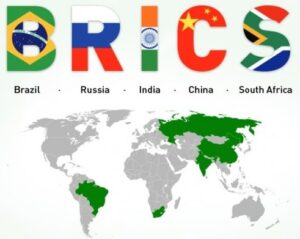Rise of New economics like Brazil, Russia, India and China (BRIC) and ASIAN countries
BRIC is the acronym that refers to the countries of Brazil, Russia, India and China, which are all deemed to be at a similar stage of newly advanced economic development.
The acronym was coined in 2001 by Jim O’Neill from investment bank Goldman Sachs in a paper entitled “Building Better Global Economic BRICs.
The grouping was originally known as “BRIC” before the inclusion of South Africa in 2010. The BRICS members are all developing or newly industrialized countries, but they are distinguished by their large, fast-growing economies and significant influence on regional and global affairs; all five are G-20 members. Since 2010, the BRICS nations have met annually at formal summits. Russia currently holds the chair of the BRICS group, and hosted the group’s seventh summit in July 2015.
EVOLUTION AND PRESENT STRUCTURE
The BRICS forum has evolved and expanded after formalization of the group. In addition to the four founder countries, it now includes South Africa, as discussed. During 2001–10, the BRIC countries achieved significant gains in both an economic and a political sense. As far as demographic and economic progress of the group is concerned, in 2010 BRICS countries collectively accounted for more than 40% of the global population and nearly 30% of the land mass. The group constituted a share of about 25% of the world GDP in PPP terms compared with 16% in 2000. This is expected to rise significantly in the near future. Along with improvements in economic indicators, the group has also realized improvement in social indicators, such as increased literacy levels.
Significant positive changes have taken place in all the BRICS countries over the last two decades (1990–2010). The economic size in nominal terms (US dollars) has increased manifold – with Brazil by over four times, India nearly five times, China over fourteen times,and South Africa by over three times. The situation further improves if comparison is made based on PPP. China has emerged as the second-largest economy, followed by India in fourth position, Russia in sixth and Brazil in eighth. The increasing trend in GDP is reflected further by a significant increase in per capita income over the last two decades.
These have brought in perceptive changes about the potential and importance of BRICS in reshaping the global economic order. The BRICS, now increasingly recognised as some of the fastest-growing countries and the engines of the global recovery process, plays a formidable role in shaping macroeconomic policy, as was observed after the financial crisis(2008–10).
FIVE factors limiting the impact of the BRICS nations:
The dominance of the Chinese economy and its role in trade relations makes the BRICS much more a China-with-partners group than a union of equal members.
- BRICS countries lack mutual economic interests. Trade between them is now less than 320 bln dollars a year and declining. Their trade with the US and EU is 6.5 times higher. China’s trade with the rest of the world is 12.5 times higher. Bilateral trade between China and South Korea is almost as large as that between BRICS nations.
- Members are too similar in some key areas. All members (apart from Russia) hold huge foreign reserves (15-35% of GDP) and have low external debt (15% to 37% of GDP.) Apart from Russia, they are heavily integrated into consumer goods production with the ‘West’.
- BRICS nations compete in third markets. In many areas, from clothing (China, India and Brazil), through economic influence in Africa (China, South Africa and India) to international aircraft and military equipment markets (China, Russia and Brazil) BRICS countries compete with one another. All are able to re-engineer and copy technologies, which means sharing R&D results and innovations and the development of cross-country scientific cooperation has limited potential.
- Diversity of cultures. Phases of economic development, ideologies, definitions of poverty and other cultural differences mean BRICS members lack common understandings about priorities that are necessary for productive sharing of experiences.


